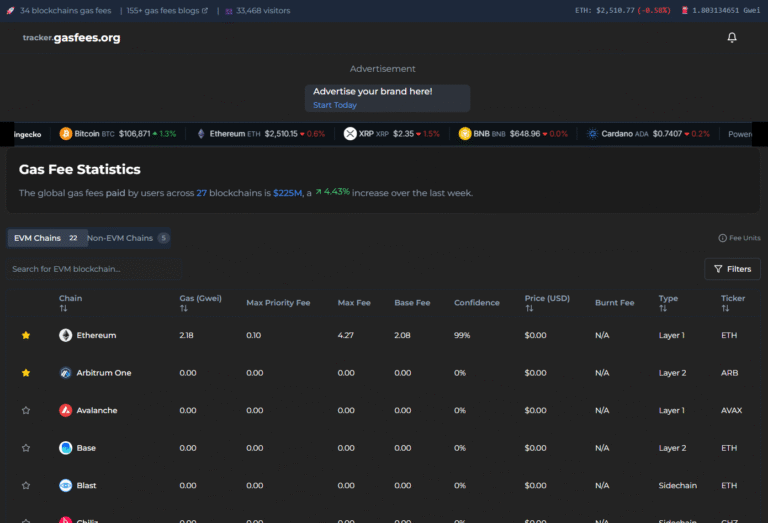
What Are Dogechain Gas Fees?
Written By: Mr. GasMan
Key Takeaways: Unlocking Dogechain with a Paw-sitive Understanding of Gas Fees
- Fueling the Dogechain engine: Dogechain uses gas fees, powered by wDOGE (wrapped Dogecoin) and DC tokens, to incentivize validators and secure the network.
- Dynamic gas prices: Just like a rollercoaster, gas fees fluctuate based on network congestion, transaction complexity, and wDOGE price.
- Fuel-efficient strategies: Plan your transactions during off-peak hours, use gas estimation tools, choose simpler transactions, and explore alternative gas payment options.
- The Dogechain vision: The team is committed to reducing gas fees through scaling solutions like sidechains and Layer 2 networks, creating a more accessible ecosystem for all Shibes.
- Unleashing your inner Doge master: Embrace the Dogechain community, ask questions, share experiences, and contribute to shaping the future of Dogecoin’s decentralized playground.
Welcome to Dogechain, fellow Shibes! Here, the iconic Dogecoin finds a playground filled with DeFi, NFTs, and exciting possibilities. But before you unleash your inner Dogefather, there’s one crucial element to understand: gas fees.
Just like the fuel gauge on your rocket-powered moon buggy, gas fees power the Dogechain engine. They incentivize “validators” (think of them as the pit crew keeping your Doge safe) to verify transactions and secure the network. But unlike gas stations on Earth, Dogechain offers two types of gas:
- wDOGE: Wrapped Dogecoin, the main fuel for most transactions. Think of it as Dogecoin wearing a fancy spacesuit for Dogechain adventures.
- DC: Dogechain’s native token, used for governance and fees in specific situations.
Navigating the Gasometer: Factors Influencing Dogechain Gas Fees
Like a rollercoaster ride, Dogechain gas fees can fluctuate. Understanding the factors behind this roller coaster is key to planning your Doge-powered journey:
- Network congestion: When the Dogechain highway gets busy, validators demand more wDOGE for their moon-fueling efforts.
- Transaction complexity: Fancy smart contracts requiring lots of computing power? Expect a higher gas bill.
- wDOGE price: If the price of wDOGE dips, you might need to pay more wDOGE per transaction to reach the same “gas price” in terms of USD.
Fuel-Efficient Tips for the Savvy Dogechain Explorer:
Worry not, Shibes! Mastering the art of gas management is within your paw-sibilities. Here are some tips to unleash your inner Dogecoin Jedi:
- Time your transactions: Dogechain’s off-peak hours (usually nights and weekends) offer smoother rides with lower gas prices.
- Utilize gas estimation tools: Before sending your Doge on a mission, tools like Dogechain Gas Tracker can help you estimate the fuel cost.
- Choose simpler transactions: Basic transfers cost less than complex smart contract interactions.
- Consider alternative gas payment options: Projects like BRIZ token offer an additional, potentially cheaper, gas payment option.
- Stay informed: Follow Dogechain’s development roadmap for updates on potential scaling solutions that could lower gas fees in the future.
Dogechain’s Vision: A Sustainable Future for Decentralized Dogedom
While gas fees exist on Dogechain, the development team is actively working on reducing their impact and increasing scalability. Their roadmap outlines exciting solutions like sidechains and Layer 2 networks, aiming to create a future where even the smallest Shibe can afford to play in the Dogechain ecosystem.
Beyond the Blog: Unleashing Your Inner Doge Master
This blog is just the beginning of your Dogechain gas fee journey. Dive deeper with these resources:
- Dogechain Documentation: https://docs.dogechain.dog/docs/overview
- Dogechain Blog: https://twitter.com/DogechainFamily
- Dogechain Community Forum: https://twitter.com/DogechainFamily
Share this blog:
Recent Gas Fees Post
Why Use GasFees.org? 🛠️
📊 Real-Time Data: Get accurate gas fee updates anytime.
🌍 All Blockchains: Layer 1 and Layer 2 covered in one place.
💸 Save Money: Optimize transactions with our insights.
🔍 Easy to Use: Designed for beginners and experts alike.









